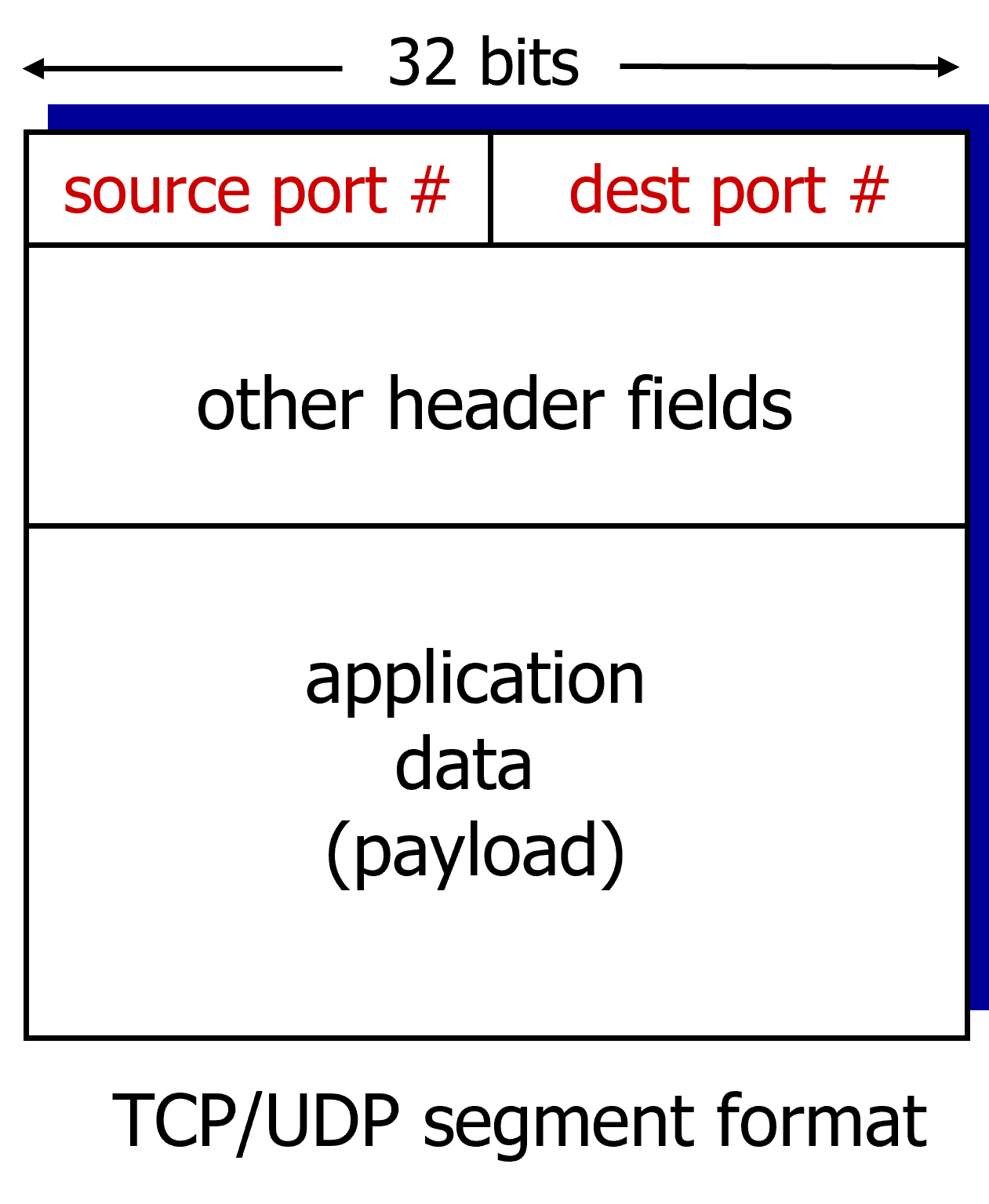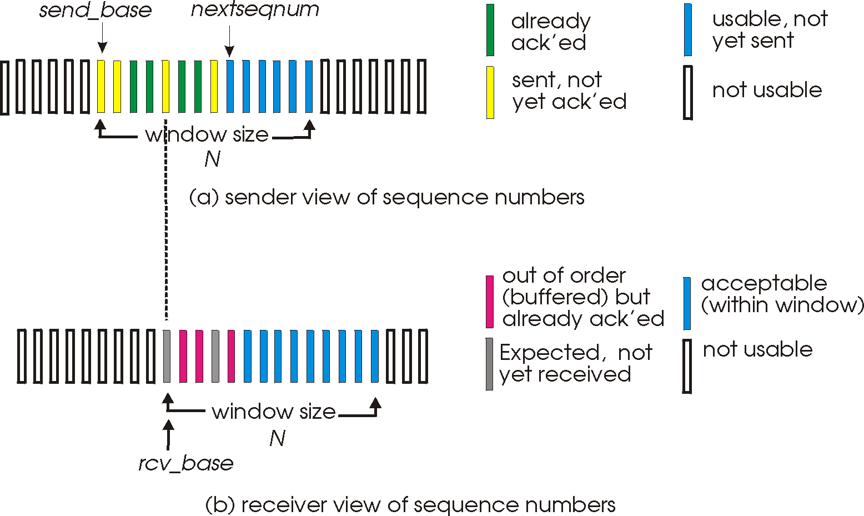Networks Midterm 2
1/31
There's no tags or description
Looks like no tags are added yet.
Name | Mastery | Learn | Test | Matching | Spaced |
|---|
No study sessions yet.
32 Terms
What's the main function of the transport layer?
Process to Process communication (Data transfer)
Different services offered by transport layer?
Reliability, time, throughput, and security
Transport layer protocol names and their services (TCP and UDP services). What services are not available?
TCP: Congestion control, Flow control, Connection oriented, reliable transport (make sure in order)
UDP: Unreliable data transfer, •no-frills extension of “best-effort” IP
Services not available:
delay guarantees
bandwidth guarantees
What are the transport layer services not provided by above protocol? (Like what's not provided with TCP and UDP)
TCP: Timing, throughput
UDP: Security
(TLS can provide security, as an add-on does not come with initially)
How transport layer helps sender sending message to destination?
TCP client initiates connection with TCP server. Uses multiplexing, demultiplexing, and sockets to get message delivered. As well as TCP and UDP
If you are developing a new transport layer protocol, what are mandatory services you need to implement?
- Processor to Process communication (Is multiplexing/demultiplexing)
- Error checking
Explain multiplexing
- Done at the sender side
- Handles data from multiple sockets, puts into one stream, add transport header
(Is used later for demultiplexing)
Explain De-multiplexing
- Done from the receiver
- Uses header into to deliver received to correct segments
Explain multiplexing, demultiplexing with help of socket
Multiplexing
- Takes data from multiple sockets, creates the header
Demultiplexing
- Uses header info to correct socket using IP address and port number
Both are in the transport and go through the network layer as well
IP tells it which device to send it to, port number determines which socket to go through

How client and server assign port number to the sockets
Has a source and destination port number
Datagram has IP address for source and destination
Host uses segment
Connectionless demultiplexing
Connectionless Demultiplexing:
- UDP
- IP/UDP datagrams with different source IP/port number but same destination it'll be received at same socket at receiving host
- When creating socket, must specify host-local port #:
DatagramSocket mySocket1 = new DatagramSocket(12534);
Connection oriented
Connection oriented demultiplexing:
- Receivers uses all four values (4-tuple) Source/Destination IP and Source/Destination Port number
- To direct segment to appropriate socket
- TCP server has "welcoming socket" - waits for connection establishment (TCP client creates sockets and sends request to here)
- When "Welcoming socket" receives the request and server creates new socket in response
- Newly created connection socket is identified by 4 values (source and destination's IP addresses and port numbers)
• Subsequent request/response is handled by the new socket
What is Checksum
Goal: Verifying packet was sent without corruption
How does it work:
Sender
- converts data into binary, gets sum of that and does 1's compliment
- treat contents of UDP segment (including UDP header fields and IP addresses) as sequence of 16-bit integers
- If overflow, add one back in on least significant bit
Receiver
- compute checksum of received segment
- check if computed checksum equals checksum field value:
• not equal - error detected
equal - no error detected. But maybe errors nonetheless?
UDP -> Basic Functions
- Process to Process (unreliable)
- Error checking
UDP advantages?
- Small header
- Fast application
- Less overhead
- Faster data transmission
Why Simple Network Management Protocol (SNMP) uses UDP?
SNMP uses UDP because of the RTT and UDP works against congestion while TCP can not (TCP throttles the user)
Why application using UDP still need to consider congestion control?
- UDP does not care and still sends data at highest rate
- Since receiver at max, packets getting sent will get lost
- Won't be able to have proper communication
How does UDP achieve error detection?
Checksum, by adding binary value of UDP segment (UDP header fields and IP address)
- checksum field is 16 bit
Explain the problem, solution, and recovery for RDT 2.0, 2.1
RDT 2.0
- Problem: Corrupted packets
- Solution: ACK, NACK, checksum, retransmit
- Recovery: ARP
RDT 2.1
- Problem: RDT 2.0 + ACK/NACK corruption
- Solution: Checksum + ACK, Sequence Number (Data)
- Recovery: R(1) Duplicate pkt = send ACK again, S(1) Corrupted -> retransmit
Explain the problem, solution, and recovery for 2.2, and 3.0 (packet corrupted + packet loss)
RDT 2.2
Problem:
Solution:
Recovery:
RDT 3.0
Problem:
Solution:
Recovery:
How to calculate sender utilization in stop and wait protocol RDT 3.0? What happens if you send more than one packet?
U sender:
(L / R) / (L / R) + RTT
If you send more than one packet:
(N * L/R) / (L/R + RTT)
Pipelining increases utilization by a factor of N Packets
Why pipelined protocols are natural next step from stop and wait?
Because with stop and wait, the sender has to wait for each packet to be responded by the receiver
- With pipelining, you can send multiple consecutive unACKed packets without needing to wait
What is window?
A sender "window" of up to N consecutive transmitted but unACKed packets
- If window full: Can't send packets
If not full: send packets
Explain GBN sender
- Sender sends N number of consecutive unACKed packets (that are within the window size)
- ACK(n): ACKs all packets up to, including seq # n
- When receiving ACK(n): move window forward to start at n + 1
- Timer on for oldest in-flight packet
- Timeout(n): retransmit packet n and all higher seq # packets in window
Explain GBN Receiver
ACK-only: always send ACK for correctly-received packet so far, with highest in-order seq #
•may generate duplicate ACKs
•need only remember rcv_base
on receipt of out-of-order packet:
•can discard (don’t buffer) or buffer: an implementation decision
•re-ACK pkt with highest in-order seq #

Explain Selective Repeat
The receiver individually ACKs all correctly received packets
Buffers packets (when needed) for in-order delivery to upper layer
Sender times-out/retransmits individually for unACKed packets
sender maintains timer for each unACKed packet
Send window
N consecutive seq #s
limts seq #s of sent, unACKed packets

What happens on the sender side of Selective Repeat?
data from above:
if next available seq # in window, send packet
timeout(n):
resend packet n, restart timer
ACK(n) in [sendbase,sendbase+N]:
mark packet n as received
if n smallest unACKed packet, advance window base to next unACKed seq #
What happens on the receiver side of Selective Repeat?
packet n in [rcvbase, rcvbase+N-1]
send ACK(n)
out-of-order: buffer
in-order: deliver (also deliver buffered, in-order packets), advance window to next not-yet-received packet
packet n in [rcvbase-N,rcvbase-1]
ACK(n)
otherwise:
ignore
What is sequence number and it’s purpose?
A unique identifier for each packet to ensure that there is proper ordering and helps the receiver know when there is an out of order packet
What is the difference between Transport vs Network layer services and protocols?
Transport: logical communication between processes (relies on or enhances network layer services)
Network: logical communication between hosts